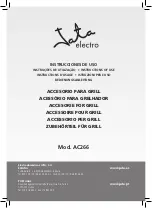
3
ENGLISH
www.louisiana-grills.com
DISPOSAL OF ASHES
Ashes should be placed in a metal container with a tight-fitting lid. The closed container of ashes should be placed on a non-combustible floor
or on the ground, well away from all combustible materials, pending final disposal. When ashes are disposed by burial in soil, or otherwise locally
dispersed, they should be retained in a closed container until all cinders have thoroughly cooled.
WOOD PELLET FUEL
This pellet cooking appliance is designed and approved for pelletized, all natural, wood fuel only. Any other type of fuel burned in this appliance will
void the warranty and safety listing. You must only use all natural wood pellets, designed for burning in pellet barbecue grills. Do not use fuel with
additives. Wood pellets are highly susceptible to moisture and should always be stored in an airtight container. If you are storing your grill, without
use, for an extended period, we recommend clearing all pellets from your grill’s hopper and auger, to prevent jams. The pellet fuel mean heating
value in 8,000 - 8,770 BTU/LB, ash content < 1%.
DO NOT USE SPIRIT, PETROL, GASOLINE, LIGHTER-FLUID OR KEROSENE FOR LIGHTING OR REFRESHING A FIRE IN YOUR
GRILL. KEEP ALL SUCH LIQUIDS WELL AWAY FROM THE APPLIANCE WHEN IN USE.
At time of printing, there is no industry standard for barbecue wood pellets, although most pellet mills use the same standards to make wood pellets
for domestic use. Further information can be found at www.pelletheat.org or the Pellet Fuel Institute. Contact your local dealer about the quality
of pellets in your area and for information on brand quality. As there is no control over the quality of pellets used, we assume no responsibility to
damage caused by poor quality of fuel.
CREOSOTE
Creosote, or soot, is a tar-like substance. When burning, it produces black smoke with a residue which is also black in color. Soot or creosote is
formed when the appliance is operated incorrectly, such as: blockage of the combustion fan, failure to clean and maintain the burn area, moisture
affected pellets, or poor air-to-fuel combustion.
It is dangerous to operate this appliance should the flame become dark, sooty, or if the burn grate is overfilled with pellets. When ignited, this
creosote makes an extremely hot and uncontrolled fire, similar to a grease fire. Should this happen, turn the unit OFF, let it cool completely, then
inspect for maintenance and cleaning. It commonly accumulates along exhaust areas.
If creosote has formed within the unit, allow the unit to warm up at a low temperature, turn off the appliance, then wipe away any formation with
a hand towel. Similar to tar, it is much easier to clean when warm, as it becomes liquid. When grease or creosote has accumulated, it should be
removed to reduce risk of fire.
CARBON MONOXIDE (“THE SILENT KILLER”)
Carbon monoxide is a colourless, odourless, tasteless gas produced by burning gas, wood, propane, charcoal or any other fuels. Carbon
monoxide reduces the blood’s ability to carry oxygen. Low blood oxygen levels can result in headaches, dizziness, weakness, nausea, vomiting,
sleepiness, confusion, loss of consciousness or death. Follow these guidelines to prevent this colourless, odourless gas from poisoning you,
your family, or others:
•
See a doctor if you or others develop cold or flu-like symptoms while cooking or in the vicinity of the appliance. Carbon monoxide poisoning,
which can easily be mistaken for a cold or flu, is often detected too late.
•
Alcohol consumption and drug use increase the effects of carbon monoxide poisoning.
Carbon monoxide is especially toxic to mother and child during pregnancy, infants, the elderly, smokers, and people with blood or circulatory system
problems, such as anemia, or heart disease.
SAFETY LISTING
In accordance with the procedures and specifications listed in the UL Subject 2728A-2019 “pellet fuel cooking appliances”
and ULC/ORD C2728-19 “for electrical features of fuel burning equipment.” Louisiana Grills pellet cooking appliances have
been independently tested and listed by CSA (an accredited testing laboratory) to UL, ULC and CSA standards.
FCC COMPLIANCE STATEMENT
This device complies with Part 15 of FCC Rules. Operation is subject to the following two conditions: (1) This device may
not cause harmful interference, and (2) This device must accept any interference received, including interference that
may cause undesired operation.
This equipment has been tested and found to comply with the limits for a Class B digital device, pursuant to part 15 of FCC Rules. These
limits are designed to provide reasonable protection against harmful interference in a residential installation. This equipment generates,
uses, and can radiate radio frequency energy and, if not installed and used in accordance with the instructions, may cause harmful
interference to radio communications. However, there is no guarantee that interference will not occur in a particular installation. If this
equipment does cause harmful interference to radio or television reception, which can be determined by turning the equipment off and
on, the user is encouraged to try to correct the interference by one or more of the following measures:
•
Reorient or relocate the receiving antenna.
•
Increase the separation between the equipment and receiver.
•
Connect the equipment into an outlet on a circuit different from that to which the receiver is connected.
•
Consult the dealer or an experienced radio/TV technician for help.
CAUTION: THE USER IS CAUTIONED THAT CHANGES OR MODIFICATIONS NOT EXPRESSLY APPROVED BY THE PARTY
RESPONSIBLE FOR COMPLIANCE COULD VOID THE USER’S AUTHORITY TO OPERATE THE EQUIPMENT.
The Bluetooth® word mark and logo are registered trademarks owned by Bluetooth SIG, Inc. and any use of such marks by Espressif is under
license. Other trademarks and tradenames are those of their respective owners.
GETTING Y
OU S
TAR
TED S
AFEL
Y




































